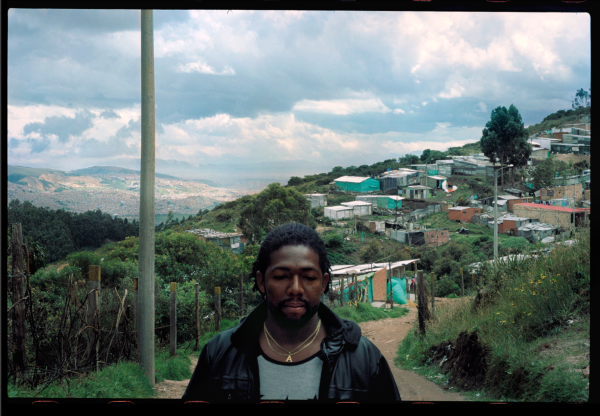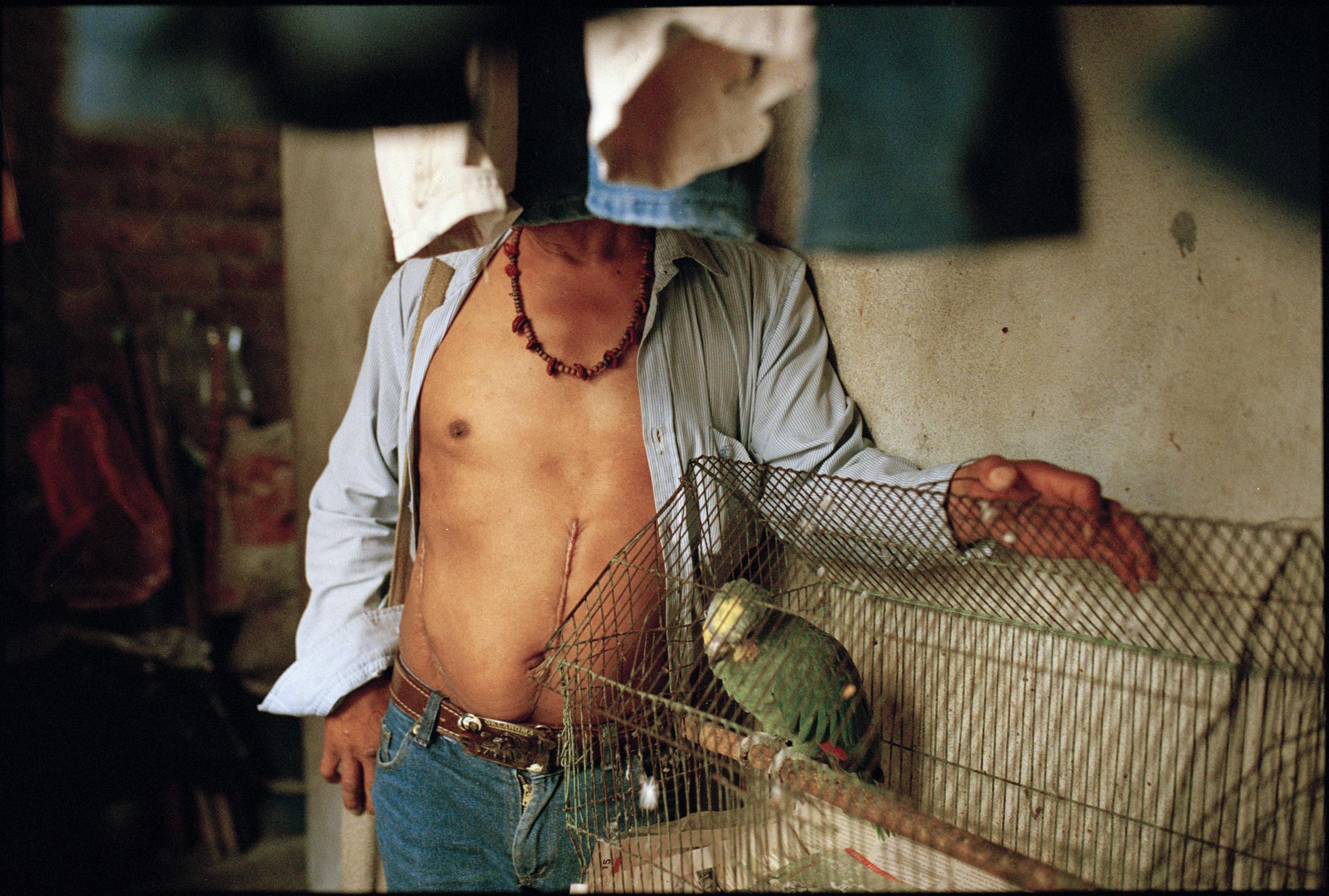
Un líder social involucrado en gestiones barriales y articulaciones de la comunidad con las entidades distritales posa para un retrato en el patio de ropas de su casa. En 2016 fue víctima de asalto con arma blanca cuando llegaba tarde en la noche a su vivienda en el sur de Bogotá. Su asaltante no intentó robarlo, solo herirlo.
Una investigación realizada en conjunto con Pacifista! reveló que desde la firma del acuerdo de paz en 2016 el número de líderes sociales que llegan desplazados a Bogotá ha ido en franco aumento. Información obtenida a partir de derechos de petición pone en evidencia que la capital se ha convertido en una suerte de refugio para quienes se ven obligados a huir de sus regiones. Según testimonios de varios líderes desplazados –recogidos a lo largo de esta investigación– la capital es el destino ideal porque pueden escapar de la violencia, denunciar hechos frente a la Fiscalía o la Defensoría del Pueblo y establecer contacto con la UNP. En las regiones, todas estas instituciones o bien no tienen presencia directa en los territorios; o están, pero los líderes no confían en ellas, pues asumen que, en buen número de los casos, se encuentran corrompidas a nivel local.
Según documentos de la Unidad Nacional de Protección (UNP), la entidad responsable del amparo de los líderes sociales, de todas las solicitudes de medidas de protección radicadas por ellos en 2018, casi un tercio fueron hechas en Bogotá, para un total de 1.189 –entre 4.811–. Mientras tanto, en los dos departamentos donde han sido asesinados la mayoría de líderes, Cauca y Antioquia, con 35 y 24 líderes asesinados en 2018 (según la Defensoría del Pueblo), el número de solicitudes de protección fue significativamente menor, 240 y 307. Este dato sugiere que los líderes no solicitan protección en los lugares donde la violencia los asedia con más fuerza.
“¿Que por qué me vine a Bogotá?” repitió en voz alta mi pregunta Álvaro*, líder promotor de proyectos agrícolas y medioambientales, minutos después de llegar desplazado a la terminal de transportes de Bogotá. “Porque acá sí se puede denunciar, allá en mi pueblo la Fiscalía está podrida, no hay Defensoría ni Personería. En el Valle no le prestan atención a uno, menos cuando uno dice que es víctima”.
Desde la firma del acuerdo de paz más de 700 líderes sociales han sido asesinados.
Según documentos de la Unidad Nacional de Protección (UNP), la entidad responsable del amparo de los líderes sociales, de todas las solicitudes de medidas de protección radicadas por ellos en 2018, casi un tercio fueron hechas en Bogotá, para un total de 1.189 –entre 4.811–. Mientras tanto, en los dos departamentos donde han sido asesinados la mayoría de líderes, Cauca y Antioquia, con 35 y 24 líderes asesinados en 2018 (según la Defensoría del Pueblo), el número de solicitudes de protección fue significativamente menor, 240 y 307. Este dato sugiere que los líderes no solicitan protección en los lugares donde la violencia los asedia con más fuerza.
“¿Que por qué me vine a Bogotá?” repitió en voz alta mi pregunta Álvaro*, líder promotor de proyectos agrícolas y medioambientales, minutos después de llegar desplazado a la terminal de transportes de Bogotá. “Porque acá sí se puede denunciar, allá en mi pueblo la Fiscalía está podrida, no hay Defensoría ni Personería. En el Valle no le prestan atención a uno, menos cuando uno dice que es víctima”.
Desde la firma del acuerdo de paz más de 700 líderes sociales han sido asesinados.
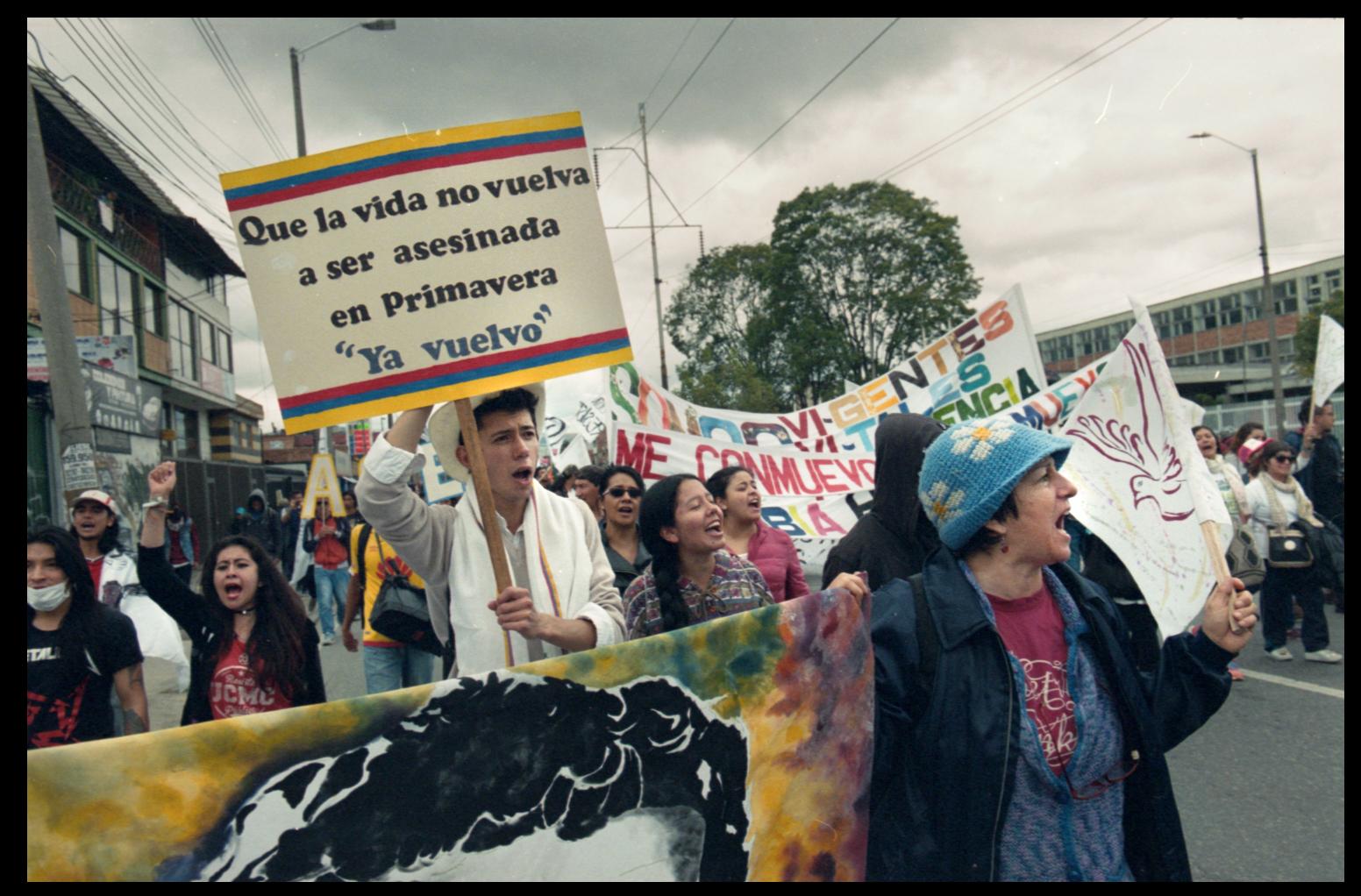
Manifestantes protestan por el asesinato de líderes sociales durante una de las marchas de oposición el día de la posesión del presidente Iván Duque.
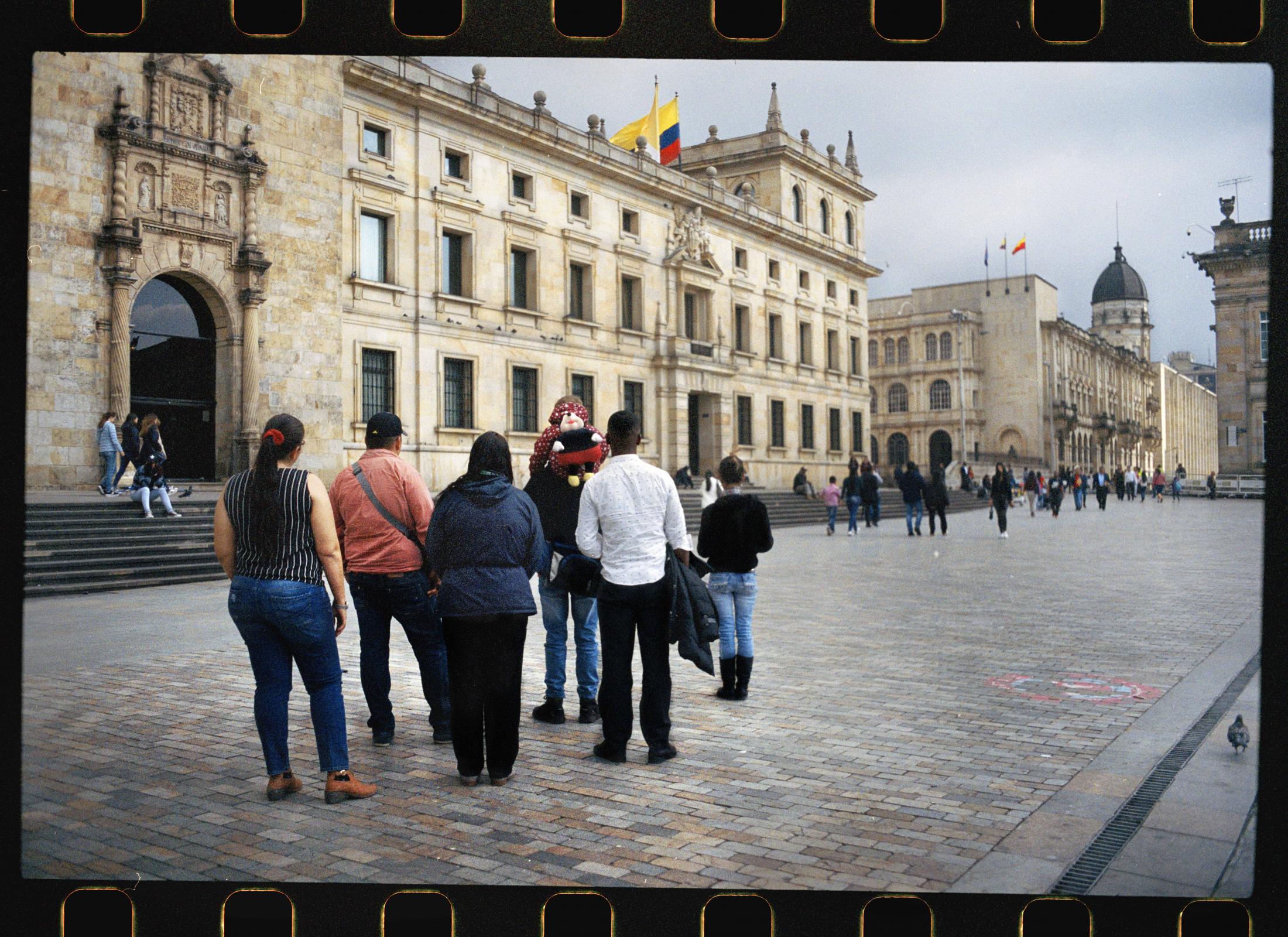
Un grupo de líderes sociales que llegaron desplazados a Bogotá de los departamentos de Bolívar, Córdoba, Huila, Santander, Valle del Cauca y Nariño posan con sus familias para un retrato en la Plaza de Bolívar. Todos ellos manifiestan que huir a la capital es un arma de doble filo, es un mecanismo de auto protección que les permite escapar del peligro pero a su vez significa el descuido si no la renuncia de su liderazgo.
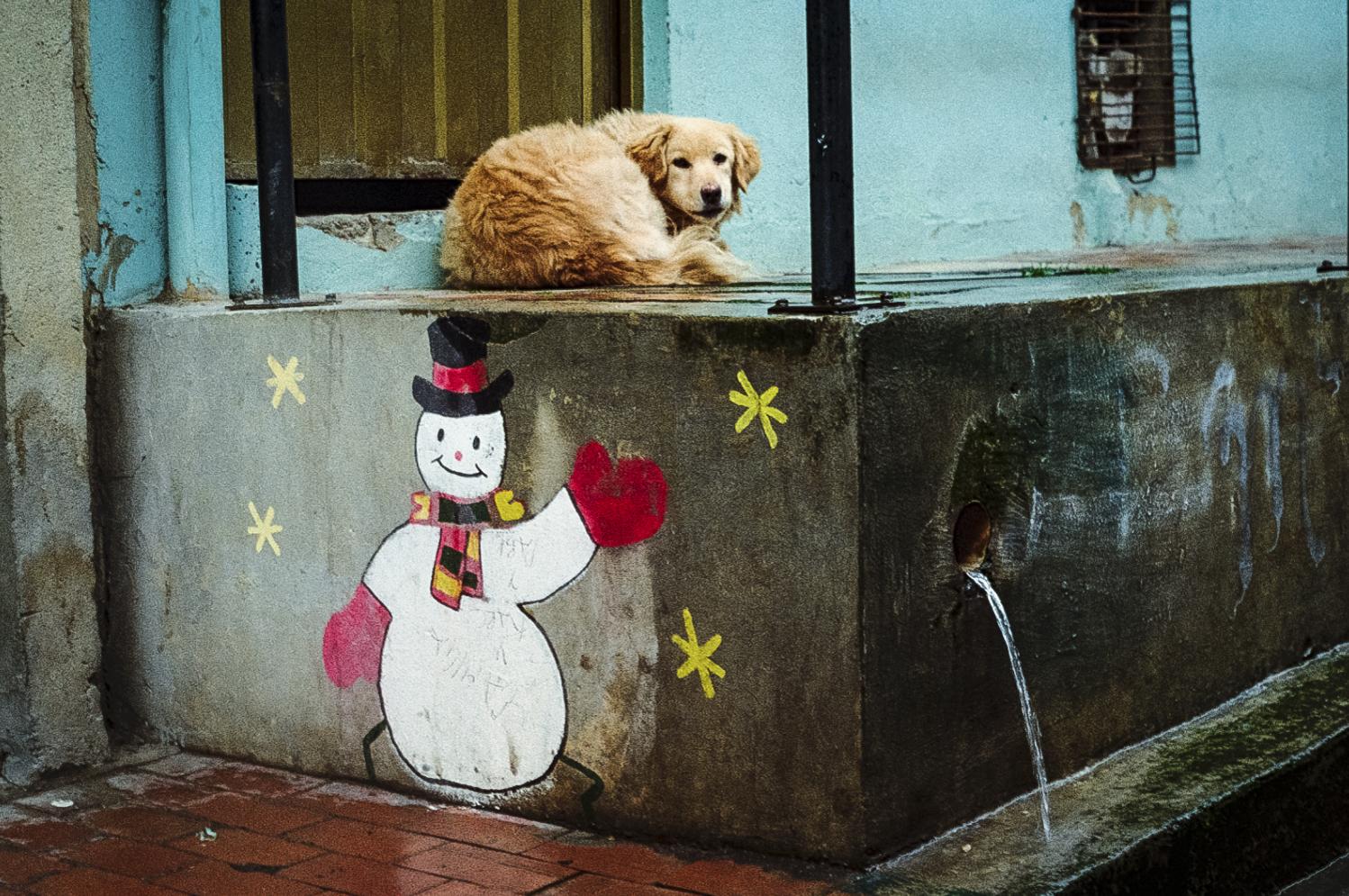
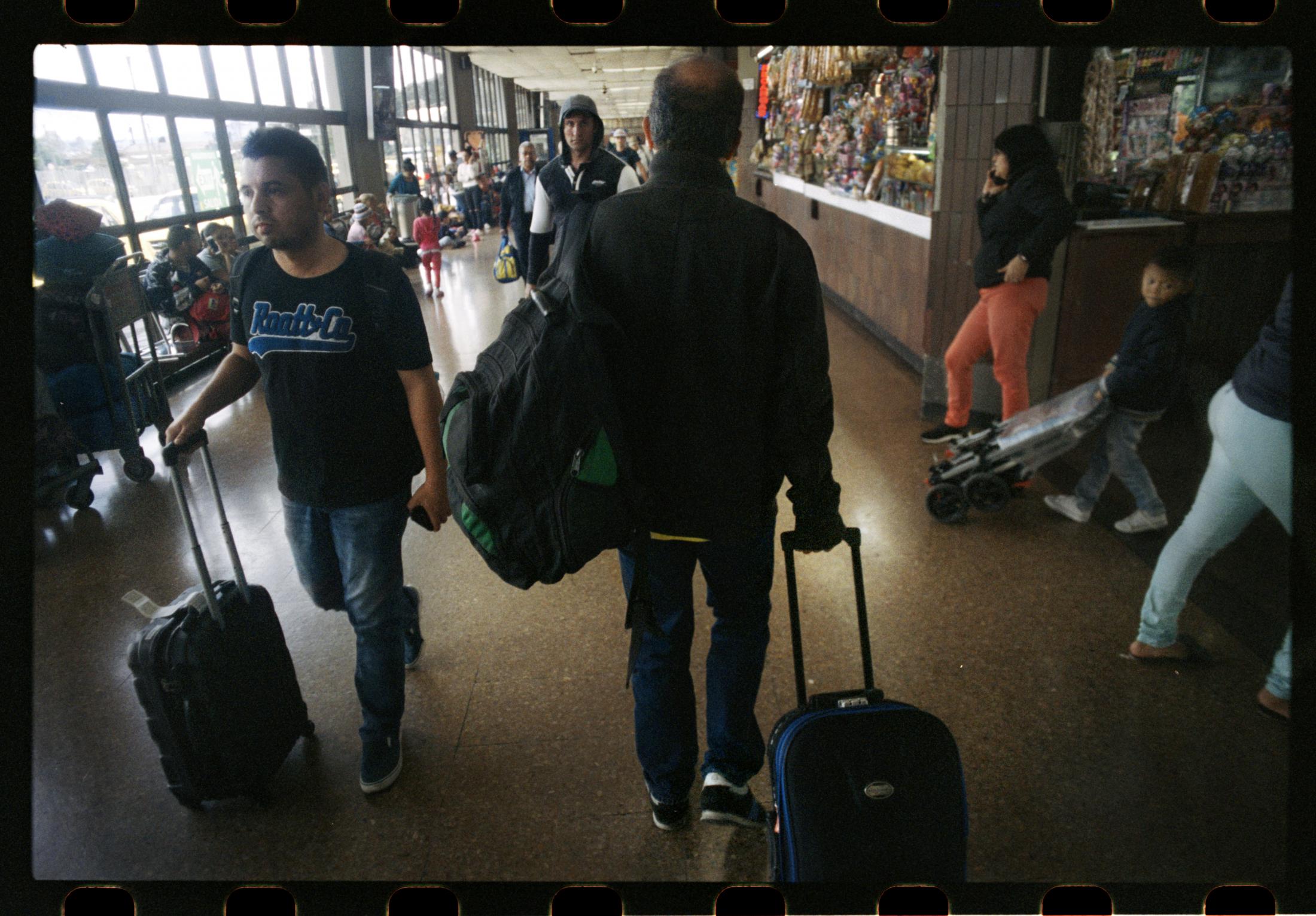
Álvaro, líder promotor de proyectos agrícolas y medioambientales, camina por la terminal de transporte de Bogotá pocas horas después de llegar desplazado desde el Valle del Cauca a raíz de que un grupo al margen de la ley le diera 24 horas para salir de su casa. Sin tener un lugar donde hospedarse, Ramírez llegó al terminal de transporte con poco dinero, una carpeta llena de documentos que dan cuenta de su liderazgo y a la expectativa de que la institucionalidad le brinde apoyo.

Dos caballos caminan frente a un bloque de viviendas de interés social en la localidad de Usme, al sur de Bogotá. La localidad ha sido constantemente mencionada por la Defensoría del Pueblo en las alertas tempranas sobre el riesgo que corren los lideres sociales en la capital. Allí, al igual que en otras localidades como Ciudad Bolívar y San Cristóbal la frontera entre ciudad y campo puede desdibujarse fácilmente.

EdgarJuanías es defensor de Derechos Humanos y promueve proyectos de desarrollo para distintas comunidades de la localidad de Usme y sus jóvenes. El jueves 6 de diciembre del 2018 recibió un panfleto que lo declaraba objetivo militar. La amenaza, firmada por las ‘Aguilas Negras’, terminaba con la oración: “Mate a un líder social y reclámenos un premio”

Una lideresa social que frente a las amenazas prefirió retirarse de los espacios de participación ciudadana sostiene a su hijo en brazos. Dice estar segura de que su trabajo por mejorar las precarias condiciones de vivienda del barrio informal en el que vive, uno de los muchos que pueblan las montañas de San Cristobal y Usme, le costó la enemistad de grupos dedicados al micro tráfico y otras economías ilegales.

Una mujer grita dentro de una atiborrada buseta que atraviesa el barrio de Santa Librada, el centro de comercio de la localidad de Usme. Aunque Santa Librada no está aislada de las instituciones y es un sector concurrido, la Defensoría del Pueblo ha reportado que es uno de los barrios de esa localidad en donde operan grupos al margen de la ley con vínculos paramilitares. Estos se lucran al delegar y tercerizar los accionares delictivos de bandas locales. Según la Defensoría estos grupos estarían detrás de amenazas a líderes sociales en la capital.

Un líder social mira fuera de la ventana del colectivo cultural del que hace parte en la localidad de Ciudad Bolívar. En ese mismo espacio, a finales de 2018, un hombre entró en medio de un concierto y lo amenazó a él y su colectivo, presuntamente por la labor social que cumplen al ofrecer talleres, cursos de derechos humanos y espacios culturales dirigidos a los jóvenes de la localidad, iniciativas que según la Defensoría del Pueblo suelen provocar amenazas hacia los líderes sociales que las promueven.

La sombra de el líder social Édgar Juanías se proyecta sobre una de las paredes de su casa. Juanías es defensor de Derechos Humanos. Su trabajo, dice, le ha causado enemistad con bandas criminales que tendrían nexos con estructuras paramilitares y que ven en su labor un obstáculo para el microtráfico y el reclutamiento de menores.

Un líder social de las comunidades afrodescendientes posa para un retrato en las instalaciones de una de las organizaciones que le han brindado apoyo desde que llegó a Bogotá buscando seguridad y protección.


Pablo Catatumbo y miembros del partido FARC marchan en protesta por el asesinato de líderes sociales durante una de las manifestaciones de oposición el día de la posesión del presidente Iván Duque. A enero de 2020 son más de 180 antiguos combatientes los que han sido asesinados en medio del conflicto que aún sacude al país.

Diego*, un ex miembro de una de las extintas red urbanas de las FARC-EP en Bogotá posa para un retrato en un establecimiento al sur de la ciudad. Como resultado del proceso de Paz decidió dejar la clandestinidad y comenzó a construir un liderazgo en la localidad de Ciudad Bolívar, en donde promueve la defensa del medio ambiente y los derechos de la juventud. Desde entonces ha sido víctima de amenazas. En el más reciente incidente hombres armados le enviaron una amenaza a Diego luego de enseñarle una foto suya a una colega a la que secuestraron durante algunas horas.

Manifestantes protestan por el asesinato de líderes sociales durante una de las marchas de oposición el día de la posesión del presidente Iván Duque.

Una lideresa social posa para un retrato frente a la quebrada Yomasa, en la localidad de Usme, al sur de la ciudad. Su gestión para preservar la naturaleza que aún rodea tramos de la quebrada le han acarreado amenazas y atentados cometidos por quienes cree son 'terreros', personas interesadas en cometer transacciones fraudulentas con los lotes aledaños a la quebrada.

Casi siempre los líderes llegan desplazados a Bogotá con sus familias. Ella es la hija de Obdulio*. "Yo entiendo la importancia de lo que mi papá está haciendo y el peligro que está dispuesto a correr. Pero no estoy de acuerdo porque algo grave le puede pasar. Yo se lo digo a usted desde la perspectiva de una hija", dice.

Una lideresa social posa para un retrato en el Sur de Bogotá. Luego de que unos de sus hijos fuera asesinado en lo que parece fue una disputa entre bandas decidió trabajar para mejorar las condiciones de vida de los jóvenes de su localidad. Desde entonces ha sido amenazada en varias ocasiones de manera anónima vía telefónica y mensaje de texto.

Con máscaras como estas líderes sociales dejan una huella simbólica en una casa de acogida en Bogotá que brinda refugio a líderes desplazados y en situaciones de alto riesgo.

Miembros del Congreso de la República se mantiene de pie y en relativo silencio durante un minuto de silencio por el asesinato de líderes sociales.


El líder social Arley Estupiñán frente al barrio informal San Germán al sur de Bogotá, a donde llegó luego de salir desplazado por un grupo paramilitar de su comunidad en el río Yurumanguí, Valle del Cauca en 2013. Los esfuerzos de Estupiñán por formalizar el barrio, proteger los derechos de sus habitantes y su intención de mejorar sus condiciones de vida lo hicieron blanco de lo que asegura son estructuras paramilitares descentralizadas que tienen intereses sobre el terreno que ocupa el barrio. Luego de un atentado y múltiples amenazas él y su familia tuvieron que salir desplazados del barrio en 2017.

Arley Estupiñán imita el movimiento que hizo en la madrugada del 13 de enero de 20178 cuando fue víctima de un atentado con arma de fuego mientras regresaba a su vivienda en el barrio San Germán, en la localidad de Usme, al norte de Bogotá. Al escuchar los disparos y ver el destello del arma colina arriba, Estupiñán saltó una cerca de puas y rodó cuesta abajo. Uno de los tres proyectiles que le dispararon alcanzó a rozar su brazo.

Una investigación realizada en conjunto con Pacifista! reveló que desde la firma del acuerdo de paz en 2016 el número de líderes sociales que llegan desplazados a Bogotá ha ido en franco aumento. Información obtenida a partir de derechos de petición pone en evidencia que la capital se ha convertido en una suerte de refugio para quienes se ven obligados a huir de sus regiones. Según testimonios de varios líderes desplazados –recogidos a lo largo de esta investigación– la capital es el destino ideal porque pueden escapar de la violencia, denunciar hechos frente a la Fiscalía o la Defensoría del Pueblo y establecer contacto con la UNP. En las regiones, todas estas instituciones o bien no tienen presencia directa en los territorios; o están, pero los líderes no confían en ellas, pues asumen que, en buen número de los casos, se encuentran corrompidas a nivel local.
Según documentos de la Unidad Nacional de Protección (UNP), la entidad responsable del amparo de los líderes sociales, de todas las solicitudes de medidas de protección radicadas por ellos en 2018, casi un tercio fueron hechas en Bogotá, para un total de 1.189 –entre 4.811–. Mientras tanto, en los dos departamentos donde han sido asesinados la mayoría de líderes, Cauca y Antioquia, con 35 y 24 líderes asesinados en 2018 (según la Defensoría del Pueblo), el número de solicitudes de protección fue significativamente menor, 240 y 307. Este dato sugiere que los líderes no solicitan protección en los lugares donde la violencia los asedia con más fuerza.
“¿Que por qué me vine a Bogotá?” repitió en voz alta mi pregunta Álvaro*, líder promotor de proyectos agrícolas y medioambientales, minutos después de llegar desplazado a la terminal de transportes de Bogotá. “Porque acá sí se puede denunciar, allá en mi pueblo la Fiscalía está podrida, no hay Defensoría ni Personería. En el Valle no le prestan atención a uno, menos cuando uno dice que es víctima”.
Desde la firma del acuerdo de paz más de 700 líderes sociales han sido asesinados.
Según documentos de la Unidad Nacional de Protección (UNP), la entidad responsable del amparo de los líderes sociales, de todas las solicitudes de medidas de protección radicadas por ellos en 2018, casi un tercio fueron hechas en Bogotá, para un total de 1.189 –entre 4.811–. Mientras tanto, en los dos departamentos donde han sido asesinados la mayoría de líderes, Cauca y Antioquia, con 35 y 24 líderes asesinados en 2018 (según la Defensoría del Pueblo), el número de solicitudes de protección fue significativamente menor, 240 y 307. Este dato sugiere que los líderes no solicitan protección en los lugares donde la violencia los asedia con más fuerza.
“¿Que por qué me vine a Bogotá?” repitió en voz alta mi pregunta Álvaro*, líder promotor de proyectos agrícolas y medioambientales, minutos después de llegar desplazado a la terminal de transportes de Bogotá. “Porque acá sí se puede denunciar, allá en mi pueblo la Fiscalía está podrida, no hay Defensoría ni Personería. En el Valle no le prestan atención a uno, menos cuando uno dice que es víctima”.
Desde la firma del acuerdo de paz más de 700 líderes sociales han sido asesinados.





















